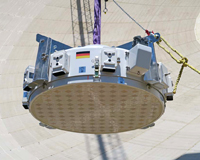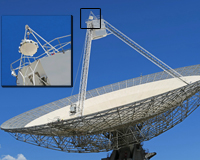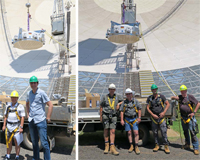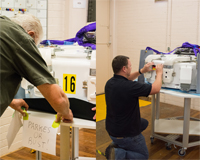Bonn-bound PAF pops by Parkes
12 February 2016
ASKAP’s awarding winning receiver technology is about to branch out beyond the Murchison Radio-astronomy Observatory in Western Australia, having been deployed to CSIRO’s Parkes Observatory this week.
Through an agreement with the Max Planck Institute for Radioastronomy in Germany (MPIfR), CSIRO has built a phased array feed (PAF) receiver especially for the Effelsberg telescope in Germany.
“The on-going development of PAF technology is a high strategic priority for us, and not only incorporates PAF development for the SKA but also demonstrates the potential for this technology to be used on other radio telescopes,” said Tasso Tzioumis, CASS Technologies Program Director.
“The PAF that we’ve built for MPIfR will be first commissioned on the Parkes 64m telescope, and will operate in the 1150 – 1800 MHz band.”
On Wednesday 10 February, one of the new PAFs being built on the Sydney workshop’s production line – #16 – was installed at Parkes over the course of the afternoon. It will remain in the focus cabin for the next eight months for characterisation tests, which will be balanced with regular maintenance and astronomical observing at the Dish.
A specially designed GPU cluster and Ethernet switch has also been installed as the backend of the PAF system, with the processing software effort being coordinated by MPIfR – a challenge in itself, with high data rates produced by the PAF requiring online data management and archiving.
Visiting during the PAF development and installation has been Gundolf Wieching, Department Head at MPIfR, and he has been pleased to see the PAF progress.
“The PAF is a key technology for future astronomy, and an exciting step towards a new generation of receivers with capabilities not previously possible,” he said, “The installation of the PAF on Parkes is a continuation of the long collaboration between the ATNF and MPIfR, and I'm looking forward to being able to use this new technology to look at the northern sky, from Effelsburg."
The primary science objective for this particular PAF will be the search for Fast Radio Bursts (FRBs), but other scientific opportunities for the receiver system will also be explored.
“As we continue to develop our PAF technology the commissioning results are already showing how valuable it is for radio astronomy,” noted Ant Schinckel, ASKAP Project Director, “We’re steaming ahead with the installation of the Mk II receivers on ASKAP, and it’s exciting that this Australian technology will be used on other telescopes around the world.”
For further information about the development of the phased array feed for MPIfR, please click here.
Back to Latest ASKAP News page.




